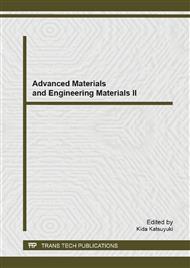[1]
L.Y. Huang, A Brief Review of Al and Al Alloy Grain Refinement. Powered By Special Casting & Nonferrous Alloys., 1997. 3(41): 41 - 43.
Google Scholar
[2]
M. Johusson, L. Backerud, and S.G. K, Study of mechanism of grain refinement of Al after addition of Ti and B-containing master alloys. Metall Trans. A., 1993. 20(2): 481 -491.
DOI: 10.1007/bf02657335
Google Scholar
[3]
Dhindaw and B. K, International Conference on Solidification Science and Processing: Out Look for the 21st Century. 2001, Science Publishers: USA.
Google Scholar
[4]
J. Campbell, Modeling of casting, welding, and advanced solidification processes VII, in Minerals, Metals and Materials Society. 1995: USA.
Google Scholar
[5]
Q.J. Zhai and C.H. Xing, Fundamental study on promotion of nucleation by com position disturbance in micro-area. Iron and Steel., 2002. 36(7): 39-41.
Google Scholar
[6]
H.P. Duan, H. Feng, and Q.H. Zhao, Effect of Mechanical Vibration onβPhase of Sn2Sb Alloy. Foundry Technology., 2004. 25(9): 686-690.
Google Scholar
[7]
Q.C. Li, ed. Basis of cast forming theory. 1982, China Machine Press: Beijing.
Google Scholar
[8]
B. CHALMER, ed. Principles of Solidification. (1964).
Google Scholar
[9]
K. Jackson, et al., On the origin of the equiaxed zone in castings. Trans . Met. Soc. AIME., 1966. 236: 149-158.
Google Scholar
[10]
G.S. COLE and G.F. BOLLING. Solidification Technology. ed. J.J. Burke. 1974, Brook Hill Publ.
Google Scholar
[11]
L. Ao, et al., Effect of Superheat Degree on Solidification Structure of 60Si2Mn Steel Billet. Iron and Steel. , 2010. 45(12): 68-72.
Google Scholar
[12]
J.C. Brice, et al., ACRT: A review of models. Progress in Crystal Growth and Characterization, 1986. 13(3): 197-229.
DOI: 10.1016/0146-3535(86)90020-1
Google Scholar
[13]
A.G. Kirdyashkin and V.E. Distanov, Hydrodynamics and heat transfer in a vertical cylinder exposed to periodically varying centrifugal forces accelerated crucible-rotation technique. Int. J. Heat Mass Transfer., 1990. 33(7): 1397-1415.
DOI: 10.1016/0017-9310(90)90038-v
Google Scholar
[14]
V.M. Masalov and G.A. EmelÕchenko, Hydrodynamics and oscillation of temperature in single crystal growth from high-temperature solutions with use of ACRTOriginal. J. Crystal Growth. , 1992. 119: 297-302.
DOI: 10.1016/0022-0248(92)90682-9
Google Scholar
[15]
P.S. Ravishankar, J.P. Dismukes, and W.R. Wilcox, nfluence of ACRT on interface stability and particle trapping behavior in directional solidification of silicon. J. CrystalGrowth., 1985. 71: 579-586.
DOI: 10.1016/0022-0248(85)90364-1
Google Scholar
[16]
S. Liu, Z.Z. Hui, and R.H. Zhou, Temperature Change and Measurement In the Process of ACRT. Chinese journal of material research., 1994. 8(3): 223-226.
Google Scholar


